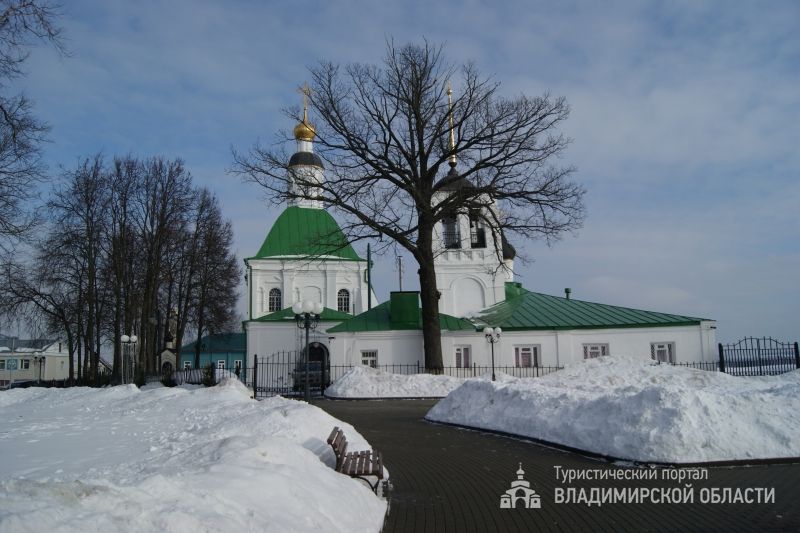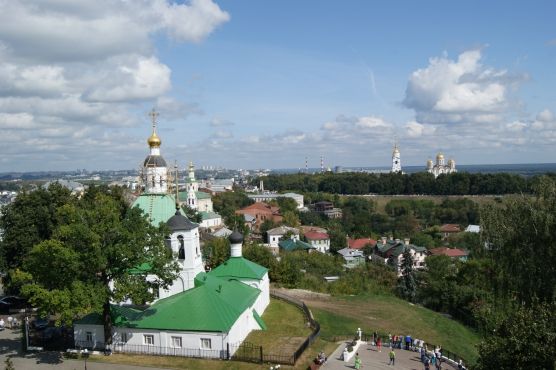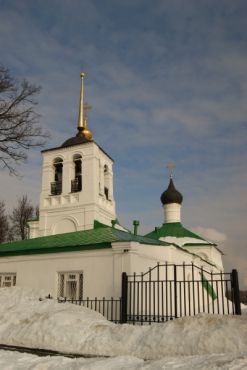Ensemble of Churches of the Savior and St. Nicholas
- Address:
- Vladimir, Spasskaya street, 8
- GPS:
- 56.12555013, 40.39958108
Not far from the Kozlov rampart, on the Spassky hill above the Patriarchal gardens there is a picturesque ensemble of churches of the Savior (Savior-Transfiguration) and St. Nicholas. According to chronicles, in place of the churches, there was the court of Prince Andrey Bogolyubsky with the white-stone church of the Savior in the 12th century. It was built in 1164 and, based on the excavations of 1953, resembled in its appearance the Church of the Intercession on the Nerl near Bogolyubov-town, built a year later. Numerous majolica tiles were found with which the floor of the Church of the Savior was paved, resembling the decoration of the floor of the palace temple in the Bogolyubov-town. After the death of Andrey Bogolyubsky, the Savior - Golden Gate Monastery was established on this site. In 1764 the monastery was abolished, and its main Church of the Savior became a parish one. On behalf of the Church of the Savior (Spasskaya Church – in Russian), the adjacent street is also named – Spasskaya.
In the 1670s, near the white-stone cold Church of the Savior, on the very edge of the hill appeared a small warm Church of St. Nicholas, one of the few preserved in Vladimir from the 17th century. The church immediately stands out with a magnificent decor: a wide border of kokoshniks, girdling the top of the facades, and a lush carved platband of the low window. The Church of St. Nicholas is adjoined by a refectory and a low belfry in the form of a square tower, the lower tier of which is decorated with blind arches and a belt of deep grooves in the wall with green tiles inside. The ringing tier is formed by wide arches on square pillars. The belfry is crowned with a spire with a tiny head at the top. Until 1850 the bell-tower had a four-sided tented completion.
The white-stone Church of the Savior existed until the terrible fire of 1778, which destroyed many of the buildings of the ancient Vladimir, after which it was dismantled. On the foundation of the ancient temple, as excavations have shown, the present Church of the Savior was erected at the end of the 18th century. The new church, of course, was very different from its ancient predecessor. But still the architects tried to repeat, although in a coarsened form, the arcature -columnar belt of the facades, the three-part division of the walls with wide pilaster-strips, the perspective keeled entrance portals. From the east to the main volume of the temple adjoins the altar apse with a miniature cupola, from the west – a covered parvis with a porch. A two-tiered octagonal drum, crowned with an onion head, rises above the four-slope high roof.
In 1937 the Church of the Savior was closed to the parishioners. The building was actually used as a grain warehouse. In the 1980s and early 1990s, the former church housed the scenery of the Vladimir Regional Drama Theater.
In 1993 the Church of the Savior was returned to the Vladimir diocese, and in 1997 – it was newly consecrated.
The ensemble of churches of the Savior and St. Nicholas today includes a memorial chapel in memory of the 2000th anniversary of Christianity, consecrated by Vladimir-Suzdal archbishop Evlogy in November 1998.
In 2014, on the site of the ancient prince's court, the Spassky hill observation deck was equipped, from where an amazing view of the Assumption Cathedral and of the distance beyond the river Klyazma opens. Sculpture of Vladimir Cherry (sculptor I.A. Chernoglazov) is located on the Spassky hill. Here begins the pedestrian zone of the old Vladimir (the so-called "Vladimir Arbat"), going through Georgievskaya street to Bolshaya Moskovskaya (Big Moscow) street.
 Tourism portal of the
Tourism portal of the

